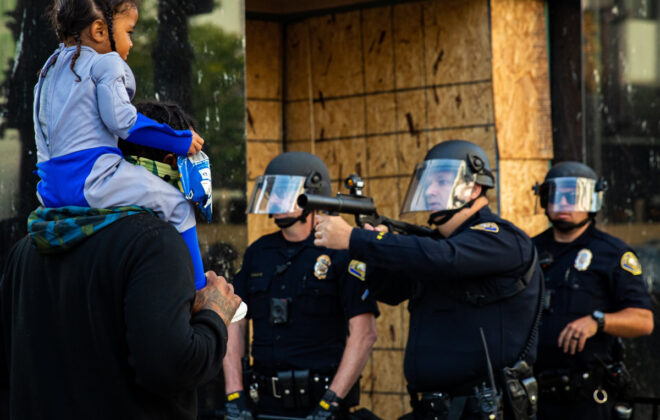We want to send greetings of solidarity and comradeship to everybody around the world, and specifically American protesters, friends and dissidents, who right know are risking everything for a brave and righteous cause. We are all part of the same struggle for justice and equality, a struggle that won’t see no end, until policing, racism and class oppression is ended.
Scroll down for an English translation of the text.
25 maj 2020 mördades George Floyd av poliser tillhörande Minneapolis polisavdelning i delstaten Minnesota. Fyra poliser deltog i gripandet av George Floyd, varav polismannen Derek Chauvin var en av de som genomförde den dödande handlingen. I mer än åtta minuter höll han sitt knä tryckt mot George Floyds nacke, även efter att han flera gånger vädjat till poliserna, ”Jag kan inte andas” – I can’t breath.
De videoklipp som fångade händelsen har sedan dess spridit sig över hela USA och världen, liksom protesterna och kravallerna i dess kölvatten. Sedan videoklippens spridning har demonstrationer mobiliserats över hela USA, varav många har bemötts med ytterligare brutalitet från polis och nationalgarde. Alltsedan den första demonstrationskvällen, då polisen försökte upplösa folkmassorna med hjälp av tårgas, har landet skördat frukten av eskalerande polistaktiker. Såsom tårgasen sprider ut motståndet över staden, så har motståndet också spridit sig över landet, med ständigt nya bränder.
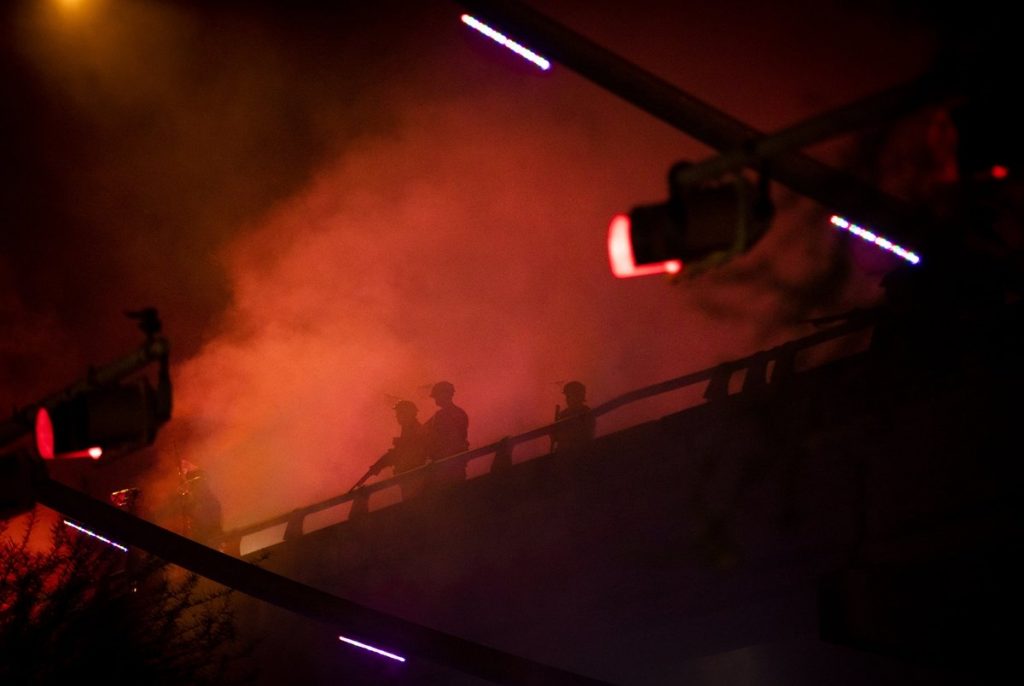
Vi har följt kravallerna, polisvåldet, upproret, och vi har känt fasa för polisens brutalitet, men också hopp för framtiden. De som idag, och ikväll, gör motstånd på gatorna i amerikanska städer, är samma människor som kommer vara med och skapa vägen in i framtiden. De lär av varandra, anpassar sina metoder, sina slagord och sina försvar, och vi lär av dem. De kämpar tillsammans på gatorna, men de bygger också upp tillsammans, lagar mat och skapar strukturer för att hjälpas åt och ta hand om varandra.
Demonstrationerna har sin grund i det amerikanska rasistiska rätts- och samhällssystemet. George Floyd blev inte gripen och dödad av polis för att han misstänktes ha använt en förfalskad sedel då han skulle handla, såsom det har påståtts, utan för att han var en svart man i fel situation, anklagad för fel sak. Det systematiska våld som svarta i USA utsätts för kan drabba vilken svart man eller kvinna som helst: en svart kund i en affär, en svart förare i sin bil, en svart pojke på en lekplats, eller en svart kvinna i sitt hem.
Det amerikanska samhället är byggt på våld mot företrädesvis landets ursprungs- och svarta befolkning, både historiskt i vår samtid. Av landets befolkningsgrupper är ursprungsfolk och svarta de som är mest utsatta för dödligt polisiärt våld, följt av latinamerikaner och vita amerikaner. Bland dessa finns även ett avsevärd utsnitt av fysiskt eller mentalt funktionshindrade personer som skjuts till döds av landets poliser.
Demonstrationerna har sin grund i det amerikanska rasistiska rätts- och samhällssystemet, men motståndet å sin sida tycks ta sig helt andra former. Slagorden ”No justice, no peace” ekar över amerikanska gator, men det är inte bara svartas röster vi hör, utan röster av alla färger, av alla nationaliteter och bakgrunder: en koalition av förbannade människor. Människor som har fått nog och sluter upp i spontana eller organiserade aktioner, i upplopp, demonstrationståg och marscher. Det är upproriska handlingar, som bemöts hårt av polis och militär. Nu är det inte längre enbart svarta som är utpekade som hot, utan folkmassan i hela sin multitud.
De upproriska handlingarna ger resultat. Atlantapolisen beklagade sig nervöst över att de befann sig i numerärt underläge, ”fyra mot en”. I Chicago höjdes under lördagen klaffbroarna över floden för att förhindra demonstranter från att ta sig till stadens välbärgade områden. Det tredje polisdistriktets kontor i Minneapolis brändes ned redan bara ett par dagar efter att George Floyd mördats av deras anställda.
.
Vi känner igen mönstret
I Europa förfasar vi oss över våldet. Vi ser den amerikanska polisens övergrepp och tänker, berättigat, att det är hemskt. Men när vi gör så, ska vi från våra åskådarplatser också påminna oss om att även på vår sidan av Atlanten ser vi regelbundet resultat av övergrepp och brutalitet från ordningsmaktens sida. Precis som i USA är det sällan som dessa incidenter faktiskt fastnar på film, men vittnesmålen är ändå många. Via initiativ som Polisbrutalitet i orten förmedlas berättelser om tunnelbaneresenärer som trakasseras av ordningsvakter, ungdomar med invandrarbakgrund som bemöts aggressivt och våldsamt när de ifrågasätter ordningsmaktens beteendee, samt oroliga föräldrar och barn som misshandlas när de vill veta vad som ska hända med deras närstående. Berättelserna om poliser i fattiga arbetarklassområden är ofta berättelser om polis som beter sig som en invasionsmakt. En polismyndighet och ordningsmakt som behandlar förorter och miljonprogramområden som platser som behöver disciplineras och tuktas.

Också Sverige har haft sina bränder – och fler gånger kommer det brinna. När polisen sköt en 68-årig man i sitt eget hem 2013 brast hela Stockholm och delar av landet ut i upplopp och spontant motstånd. Bränderna från dessa upplopp är sedan länge släckta, men vi håller dem i minnet, tillsammans med andra, våldsamma minnen från möten med ordningsmakten. Så länge som vi lever med en polismakt där 3917 brott kan utföras av polis på ett år, men endast 19 ens leder till åtal, kommer det finnas skäl att hålla dem i minnet. Så länge som kvinnomisshandel och misshandel hör till polisers vanligaste brott utanför tjänsten kommer det finnas skäl att komma ihåg hur man gör motstånd.
Vi har inte glömt ljudet av polishästar som urskiljningslöst rider över antifascister i Limhamn. Vi har inte glömt ekot av ett barns huvud som slås mot marken i Malmö centralstation. Vi har inte glömt ordningsvakterna som traumatiserade en gravid kvinnas barn efter anklagelsen för tjuvåkning i Stockholms tunnelbana. Vi har inte glömt mannen som kvävdes till döds av poliser och väktare på sjukhuset i Västerås. Vi har inte glömt den funktionsnedsatte man som sköts till döds av fyra poliser, varav tre åtalades men friades för att ha avlossat 25 skott mot mannen. Vi glömmer ingen av alla de människor som har dött i svenska polisarrester och i isoleringsceller.
Elden har redan hunnit börja sprida sig till Europa, med protester eller upplopp mot polisvåld och rasism i såväl Amsterdam som Paris och Stockholm. Gnistorna sprakar nu överallt. Det går i skrivande stund inte att säga var upproren kommer få fäste härnäst.
.
Komplotten mot de mäktiga
Röken från tårgasgranater och brinnande polishus har inte ens hunnit lägga sig innan president Donald Trump deklarerar att det folkliga upproret på gatorna i landets större städer är en komplott av urban krigföring, planerad och utförd av antifascister. Reaktionära rop efter grövre repression, större militära insatser och terrorklassning av antifascistiska sociala rörelser sprider sig högljutt, men dessa rop ter sig i upprorsmakarnas öron mer som skrämda viskningar och undanflykter. Den som följer rörelsernas utveckling kan tydligt se att det rör sig om mångsidiga, breda och inkluderande rörelser, protester och motståndsvågor. Upproret sprider sig och besvaras med allt grövre våld, men ännu tycks inte ens gummikulor eller bepansrade fordon kunna rå på den alltmer synliga, uttalade och handlingskraftiga frustration som tar sig form på amerikanska gator och torg.
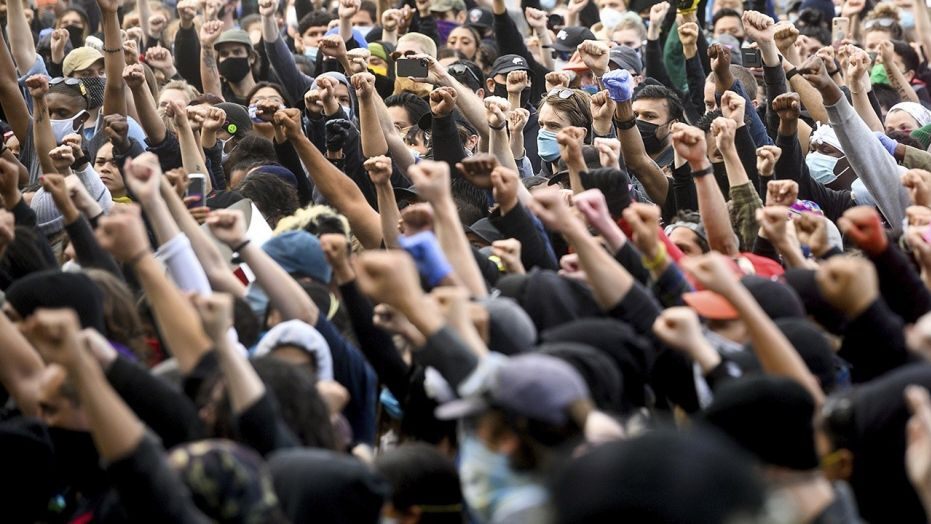
Men, hur är det nu med de mytomspunna antifascisterna, terrorförklarade av den amerikanska presidenten, fruktade av den splittrade alternativhögern? Kan det verkligen vara så som Donald Trump själv säger på Twitter, att de ligger bakom protesterna och upploppen?
Ja, vem vet? Vi finner det enklast att besvara dessa frågor genom att låna en bevingad formulering av Subcomandante Marcos:
Angående allt prat om huruvida antifascister ligger bakom upproret: vi är gatukämparna på Minneapolis gator, vi är gay i Warszawa, svarta i Sydafrika, asiater i Europa, chicanos i San Isidro, anarkister i Spanien, palestinier i Israel, mayaindianer på San Cristóbals gator, judar i Tyskland, romer i Europa, ursprungsfolk i Quebec, samer i Kiruna, en ensam kvinna i tunnelbanan klockan tio på natten, arbetslösa arbetare och timanställda studenter.
Antifascister är vi, som vilken människa som helst i den här världen. Vi är alla de förtryckta minoriteter när de gör motstånd, exploderar och säger ”Nu räcker det!”, ”Ya basta”, ”Black lives matter!”. Vi är alla de otolererade som när de talar tvingar majoriteten och de mäktiga att lyssna. Vi är de förtryckta när de söker ett ord, sitt ord – det ord som ger majoriteten tillbaka åt de evigt fragmenterade, vi.
Koalitionen av förbannade människor.
Det kan som boende i Sverige vara svårt att hitta sätt att delta i den pågående kampen. För att stötta rörelsen ekonomiskt och hjälpa de tusentals människor som utsatts för repression och blivit gripna, eller stötta infrastrukturerna bakom rörelsen, se en sammanställning av länkar och kampanjer här: blacklivesmatters.carrd.co
.
English translation
.
On May 25, 2020, police officers belonging to the Minneapolis Police Department murdered George Floyd in the state of Minnesota. Four police officers took part in the arrest of George Floyd, of whom police officer Derek Chauvin was one of the executors. For more than eight minutes officer Chauvin kept his knee pressed against George Floyd’s neck, even after Floyd repeatedly appealed to the police, “I can’t breathe”.
The videos that captured the killing of George Floyd have since spread throughout the United States and the world, and so have the protests in its wake. Since the spread of the videos, demonstrations have been mobilized across the United States, many of which have been met with further brutality by police and the National Guard. Ever since the first night of protests, when the police tried to dissolve the crowds with tear gas, the country has reaped the rewards of ever escalating police tactics. As the tear gas spreads resistance across the city, so too has the resistance spread across the country, with ever-new fires.
We have followed the riots, the police violence, the uprising, and we have felt the horror of police brutality, but also hope for the future. Those who today, and maybe tonight, are resisting in the streets of American cities, are the same people who will create the path into the future. They learn from each other, adapt their methods, their slogans and their defenses, and we learn from them. They fight on the streets together, but they also build together, cook and create structures to help and care for each other.
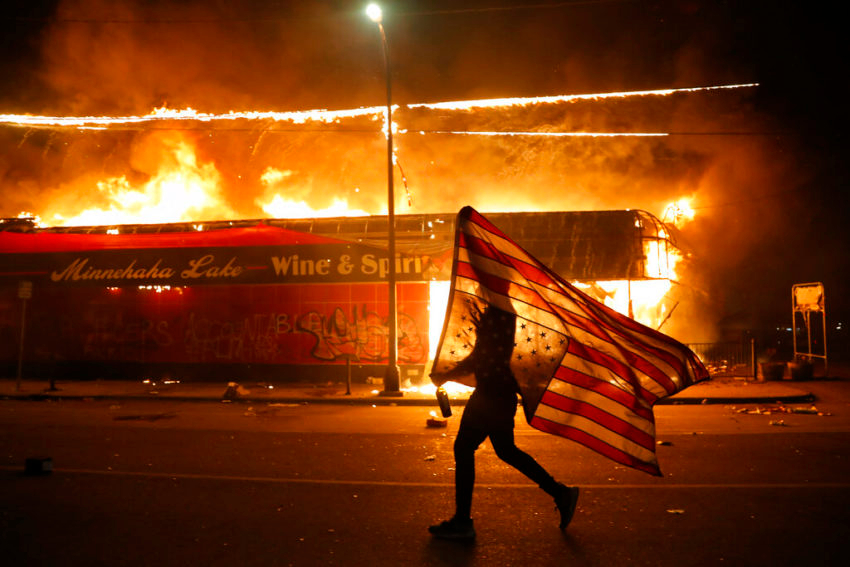
The demonstrations are a response to the racist American justice system and the racist American social system as a whole. George Floyd was not arrested and killed by the police for allegedly using a counterfeit banknote, as has been alleged, but because he was a black man in the wrong situation, accused of the wrong thing. The systematic violence that blacks in the United States are subject to can affect any black man or woman: a black customer in a store, a black driver in their car, a black boy at a playground, or a black woman in her home.
American society is built on violence against the country’s indigenous and black population, both historically in our time. Of the country’s population groups, indigenous peoples and blacks are the most vulnerable to deadly police violence, followed by Latin Americans and then white Americans. Among these, there is also a considerable section of physically or mentally disabled persons who have been shot to death by the country’s police officers.
The slogan “No justice, no peace” echoes across American streets, but it is not just the voices of black people we hear, but voices of all colors, of all nationalities and backgrounds: a coalition of pissed-off people. People who have had enough and now join in spontaneous or organized actions, riots, demonstration and marches. These are acts of rebellion, which are dealt with severely by the police and the military. Now it is no longer just black people who are designated as threats, but the crowd in their whole multitude.
The rebellious acts produce results. The Atlanta police complained nervously that they were in a numerical disadvantage, “four to one”. In Chicago, on Saturday, the bridges were raised across the river to prevent protesters from accessing the city’s affluent areas. The office of the Minneapolis Police third precinct was burnt down just a few days after George Floyd was murdered by their officers.
.
We recognize the pattern
In Europe we are horrified by the violence. We see the US police abuse and think, justifiably, that it is horrible. But when we do so, we should also remind ourselves from our spectator view that even on our side of the Atlantic we regularly see the results of abuse and brutality on the part of the justice system. Just as in the United States, these incidents are rarely caught on film, but the testimonies are many. Via initiatives such as “Polisbrutalitet i orten” (translated to Police brutality in the hood), stories are spread about subway travelers who are harassed by security guards, young people with immigrant backgrounds who are aggressively and violently confronted when questioning the behavior of police officers, and concerned parents and children who are assaulted when trying to get answers to what is going to happen their loved ones. The stories of police in poor working class areas are often stories of police acting as an invasion force. A police authority that treats housing project areas as places that need to be disciplined and chastised.
Sweden has also had its fires – and there will be more fires in the future. When the police shot a 68-year-old man in his own home in 2013, all of Stockholm and parts of the country erupted in riots and spontaneous resistance. The fires from these riots have been extinguished for a long time, but they live on in our memories, along with other, violent memories from meetings with the police. As long as we live with a police force where 3917 crimes can be committed by police in a year, but only 19 lead to prosecution, we will have reasons to keep our memories of the fires alive. As long as battery against women and assults are among the most common offenses by police outside the service, there will be reasons to resist.

We have not forgotten the sound of police horses trampling indiscriminately over anti-fascists in Limhamn. We have not forgotten the echo of a child’s head being hit against the ground in Malmö Central Station. We have not forgotten the security guards who traumatized a pregnant woman’s child following suspicion of fare evasion in Stockholm’s subway. We have not forgotten the man who was choked to death by police and security guards at the hospital in Västerås. We have not forgotten the disabled man who was shot dead by four police officers, three of whom were prosecuted but released for firing 25 shots at the man. We do not forget any of the people who have died in Swedish police stations and in isolation cells.
The fire has already begun to spread to Europe, with protests or riots against police violence and racism in both Amsterdam, Paris and Stockholm. The sparks now burst everywhere. At the time of writing, it is not possible to say where the rebellion will take hold next.
.
The plot against the mighty
The smoke from tear gas grenades and burning police stations has not even settled before President Donald Trump declares that the popular uprising on the streets of the country’s major cities is a plot of urban warfare, planned and carried out by anti-fascists. Reactionary cries are heard for greater repression, major military efforts and terrorist classifications of anti-fascist social movements are spreading loudly, but these cries from reactionaries sound in the ears of insurgents more like frightened whispers and excuses. Those who follow the developments of the movements can clearly see that they are versatile, broad and inclusive movements, protests and waves of resistance. The insurgency is spreading and being answered with ever greater violence, but even rubber bullets or armored vehicles do not seem to be able to handle the increasingly visible, pronounced and actionable frustration that is taking shape on American streets and squares.
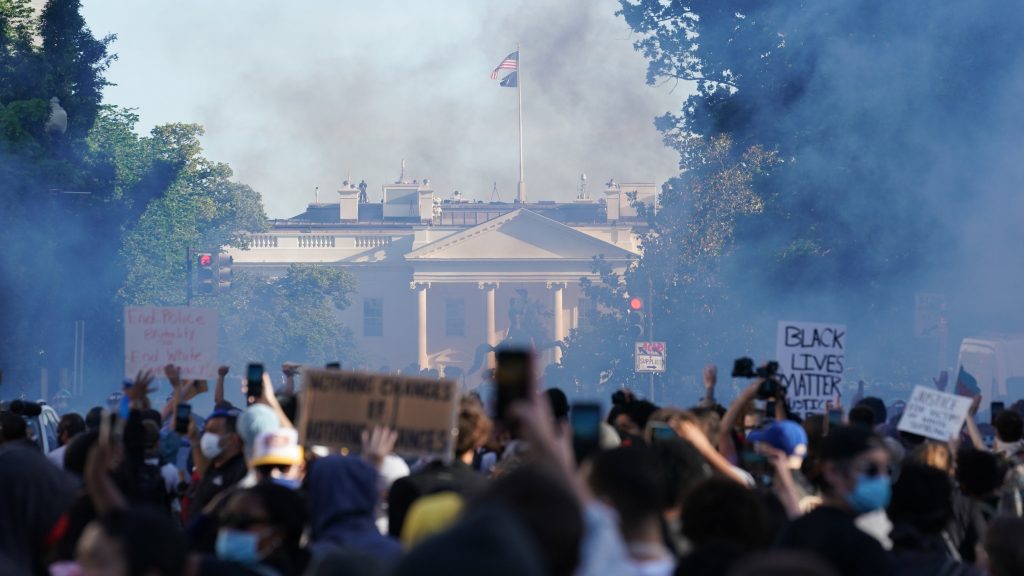
But, what about the mythical anti-fascists, declared terrorists by the US president, feared by the divided alternative right? Can it really be as Donald Trump himself is saying on Twitter, that they are behind the protests and riots?
Who knows? We find it easiest to answer these questions by borrowing and paraphrasing some of Subcomandante Marco’s words:
As to whether anti-fascists are behind the uprising: we are the street fighters of Minneapolis, we’re gay in Warsaw, blacks in South Africa, Asians in Europe, chicanos in San Isidro, anarchists in Spain, Palestinians in Israel, Mayans in San Cristobal’s streets, Jews in Germany, Roma in Europe, native peoples in Quebec, Sami in Kiruna, a lone woman in the subway at ten o’clock at night, unemployed workers and hourly payed students.
Anti-fascists are like any human in this world. We are every oppressed minority who is now resisting, exploding and saying “Enough is enough“, “Ya basta”, “Black lives matter!”. We are every untolerated group who, by speaking, are forcing the majority and the powerful to listen. We are the oppressed when they seek a word, their word – the word that gives the majority back to the eternally fragmented, we.
The Coalition of Pissed-Off People.
As residents of Sweden, finding ways to participate in the ongoing struggle can be difficult. To support the movement financially and help the thousands of people who are facing repression and getting arrested, or supporting the infrastructure behind the movement, see a compilation of links and campaigns here: blacklivesmatters.carrd.co

